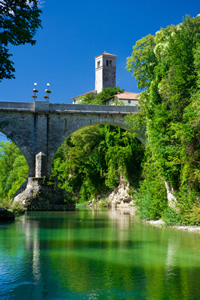Cividale del Friuli
Cividale del Friuli - tourist information
Unesco heritage
Perched on the banks of the Natisone River, Cividale del Friuli has developed and maintained intact over the centuries a noble and austere imprint, worthy of a capital of great strategic importance, marked and enriched by the passage of foreign peoples: Lombards and Franks.
We therefore set out to discover the city, crossing the Natisone River on the Ponte del Diavolo (Devil's Bridge), and starting from the heart of its historic centre, Piazza del Duomo. Our gaze is immediately captured by the imposing Basilica di Santa Maria Assunta, whose luminous white stone façade shows clear signs of its time of construction. The building was in fact constructed from the 15th to the 18th century, in the Gothic Venetian style. The measured grandeur of the interior offers many points of admiration: among others, the marvellous silver altarpiece of Pellegrino II, placed on the altar, made of embossed silver foil with fire gilding, which is one of the masterpieces of medieval Italian ornamentation. On the left aisle is a large wooden crucifix from the 13th century, while moving to the right aisle leads to the Christian Museum, which houses some precious masterpieces of Longobard sculpture.
Worthy of note is the Baptistery of Callisto, an octagonal shrine, adorned with beautiful sculpted decorations, dating back to the mid-8th century, and above all, the Altar of Ratchis, dedicated to the homonymous king of the Lombards, as well as duke of Cividale: it is a parallelepiped in richly decorated Karst stone, considered one of the most important artistic manifestations of the early Middle Ages.
Let us return outdoors to Piazza del Duomo and pause in front of Palazzo de Nordis, built in the late 15th century, or the imposing Palazzo dei Provveditori Veneti, which closes off the eastern side of the square like a scenographic backdrop. Erected in 1565, most probably to a design by Palladio, it now houses the National Archaeological Museum.
Taking Corso Mazzini, the town's main street, you will plunge deeper and deeper into the ancient soul of Cividale, as far as Piazza Paolo Diacono, which is daily animated by the picturesque herb market. Surrounded by interesting old buildings, with traces of frescoes and windows emphasised by terracotta cornices, it is dedicated to the most famous Lombard historian, whose house, commemorated by a plaque, stood in this very square.
Leaving the square and getting a little lost in the streets, passing by the mighty fortification walls that enclose the majestic city gates, one comes across churches that behind their authentic stone façades, often hide unexpected treasures: such as a splendid altarpiece by Palma il Giovane in San Pietro ai Volti or the ceiling entirely frescoed in the Church of San Silvestro and San Valentino. Not to mention the purity of the lines of San Francesco, located in the square of the same name next to Palazzo Pontotti-Brosadola, whose exterior does not hint at the beauty of the interior. Built at the height of the 18th century, between the marble staircase and the splendid ballroom, it preserves the best cycle of frescoes in Cividale, offering a unique and sumptuous overview.
Retracing one's steps, behind the cathedral, the air one breathes smells of ancient Lombard echoes, here more than ever.
A little further on, behind the Church of St John the Baptist, you find yourself in Piazza San Biagio, on which, in addition to the small Church of San Biagio, there is the hanging passageway that, amidst the enchantment of the greenery on the walls, leads to the famous Lombard Temple, the highest expression of the Western High Middle Ages. In front of the 8th-century building, there is a beautiful view of the Natisone River flowing between the deep, steep walls. Via Monastero Maggiore, with its characteristic irregular cobblestones, leads directly to the Celtic Hypogeum, a curious and interesting complex of artificial caves, excavated at different levels and reached by steep but suggestive flights of steps.
Brochure INTERNATIONAL MUSIC MASTERCOURSES
Informativa sulla Privacy | Privacy Policy | Cookie Policy | Mappa del sito
powered by START 2000